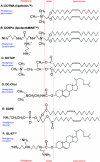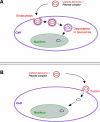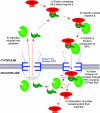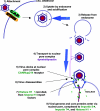Novel molecular approaches to cystic fibrosis gene therapy
- PMID: 15656784
- PMCID: PMC1134927
- DOI: 10.1042/BJ20041923
Novel molecular approaches to cystic fibrosis gene therapy
Abstract
Gene therapy holds promise for the treatment of a range of inherited diseases, such as cystic fibrosis. However, efficient delivery and expression of the therapeutic transgene at levels sufficient to result in phenotypic correction of cystic fibrosis pulmonary disease has proved elusive. There are many reasons for this lack of progress, both macroscopically in terms of airway defence mechanisms and at the molecular level with regard to effective cDNA delivery. This review of approaches to cystic fibrosis gene therapy covers these areas in detail and highlights recent progress in the field. For gene therapy to be effective in patients with cystic fibrosis, the cDNA encoding the cystic fibrosis transmembrane conductance regulator protein must be delivered effectively to the nucleus of the epithelial cells lining the bronchial tree within the lungs. Expression of the transgene must be maintained at adequate levels for the lifetime of the patient, either by repeat dosage of the vector or by targeting airway stem cells. Clinical trials of gene therapy for cystic fibrosis have demonstrated proof of principle, but gene expression has been limited to 30 days at best. Results suggest that viral vectors such as adenovirus and adeno-associated virus are unsuited to repeat dosing, as the immune response reduces the effectiveness of each subsequent dose. Nonviral approaches, such as cationic liposomes, appear more suited to repeat dosing, but have been less effective. Current work regarding non-viral gene delivery is now focused on understanding the mechanisms involved in cell entry, endosomal escape and nuclear import of the transgene. There is now increasing evidence to suggest that additional ligands that facilitate endosomal escape or contain a nuclear localization signal may enhance liposome-mediated gene delivery. Much progress in this area has been informed by advances in our understanding of the mechanisms by which viruses deliver their genomes to the nuclei of host cells.
Figures





References
-
- Bobadilla J. L., Macek M., Fine J. P., Farrell P. M. Cystic fibrosis: a worldwide analysis of CFTR mutations — correlation with incidence data and application to screening. Hum. Mutat. 2002;19:575–606. - PubMed
-
- FitzSimmons S. C. The changing epidemiology of cystic fibrosis. J. Pediatr. 1993;122:1–9. - PubMed
-
- Frederiksen B., Lanng S., Koch C., Hoiby N. Improved survival in the Danish centre treated cystic fibrosis patients: results of aggressive treatment. Pediatr. Pulmonol. 1996;21:153–158. - PubMed
-
- Quinton P. M. Chloride impermeability in cystic fibrosis. Nature (London) 1983;301:421–422. - PubMed
-
- Knowlton R. G., Cohen-Haguenauer O., Van Cong N., Frezal J., Brown V. A., Barker D., Braman J. C., Schumm J. W., Tsui L., Buchwald M., Donis-Keller H. A polymorphic DNA marker linked to cystic fibrosis is located on chromosome 7. Nature (London) 1985;318:380–382. - PubMed
Publication types
MeSH terms
Substances
LinkOut - more resources
Full Text Sources
Other Literature Sources
Medical

